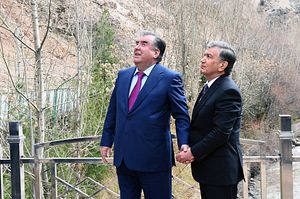The Turkmenistan-Afghanistan-Tajikistan (TAT) railway line looks to be a casualty of warming Tajik-Uzbek relations as officials suggested recently that Tajikistan would postpone its work on the line.
According to a brief Associated Press report, Tajikistan’s ambassador to Uzbekistan, Imom Sodiq Ashourboyzoda, said that Dushanbe had decided to indefinitely postpone building a railroad intended to connect Tajikistan with Turkmenistan via Afghanistan. As the AP put it, “[t]he ambassador said the plan is no longer feasible because of an improvement in ties with its ex-Soviet neighbor, Uzbekistan.”
Rail has long been all the rage for the landlocked countries of Central Asia. While Soviet era projects connected the Central Asian region to Moscow, Chinese efforts in the Belt and Road Initiative (BRI) era loft the possibility of greater connection to the wider Eurasian landmass, bookended by China and Europe. Other projects since independence have sought the sea, looking south to Afghanistan, Pakistan, and Iran for global connections.
Uzbekistan, doubly landlocked and bordering every other Central Asian state, is pivotal to a functioning regional rail network. Uzbekistan is especially important for mountainous Tajikistan’s access to the rest of Central Asia. Rail, or more specifically, the blocking of Tajik rail traffic, has featured as frequent Uzbek political weapon over the years. In the war of words over water — which the late Uzbek President Islam Karimov once threatened could lead to a real war — Tashkent was enraged by Dushanbe’s efforts to construct the Rogun mega-dam, and used railways to fight back.
The Rogun dam was first suggested in 1976, but by the time of the Soviet Union collapse in 1991 little had been done. Then came a civil war, a cratered economy, and several deals with Russian firms to complete the project that made little progress before being dissolved. In 2009, when one such deal with a Russian firm fell through, Dushanbe decided to try and raise funds to complete the project itself. In 2012, when the World Bank began an impact assessment, work was halted. After the assessment was completed in 2014, greenlighting the project, Tajikistan began to move more purposefully toward making the dam dream a reality.
In this time period, from 2009 to 2012 in particular, Uzbekistan wielded its rail connections as a weapon to punish Tajikistan. In 2010, for example, Tajik authorities complained that Uzbekistan had stranded about 2,500 Tajikistan-bound railway cars in Uzbekistan. Uzbek authorities blamed the traffic stoppage on technical issues putting a stretch of rail connecting Uzbekistan to Khatlon province in Tajikistan out of order. Repairs, Uzbek officials said at the time, were impossible because of seismic activity and floods and rejected Tajik offers to complete repairs.
Then in November 2011, a railway bridge in Uzbekistan near the Afghan border was blown up. The immediate explanation — terrorism — seemed to make sense, given that some NATO supplies were being shipped into Afghanistan via Uzbekistan. But, a Eurasianet article noted shortly after the incident, “while the U.S. military traffic to Afghanistan wasn’t affected by the blast, shipping to neighboring Tajikistan — with which Uzbekistan has chronically bad relations — has been.”
The shenanigans continued into 2012, with further stoppages of Tajik-bound trains and new tariffs.
Surprising none, Tajikistan actively sought a way around Uzbekistan. Enter the Turkmenistan-Afghanistan-Tajikistan (TAT) railway, launched in 2013, which would — if completed — circumvent quarrelsome Uzbekistan. In late 2016, Turkmenistan completed the first small transnational leg of the project, pulling a train into the first station, Aqina, on the Afghan side of the border from Imamnazar in Turkmenistan. No notable developments followed, however, with questions lingering over the exact route and funding for the Afghan and Tajik portions of the rail.
2016 proved pivotal for other reasons as well. First, the Rogun project took a big step forward with the awarding of a construction contract in July to Salini Impregilo, an Italian company. At that point the plan was to have two of the planned six turbines up and running by 2018. Reports this summer suggested that one of the turbines will be inaugurated in November and the second in April 2019.
Then Karimov died and with him Uzbekistan’s staunchest opponent of the Rogun dam project. Indeed, Karimov’s successor, Shavkat Mirziyoyev, has gone to great lengths to revive Uzbek-Tajik relations. During his historic visit to Tajikistan in March 2018, Mirziyoyev appeared to drop Uzbekistan’s opposition to the project.
With this backdrop, Tajikistan’s scuttling of the TAT railway is unsurprising, though maybe shortsighted. On the one hand, the project would be expensive — one estimate pegged it at $2 billion — and difficult, given the fluid security situation in Afghanistan. On the other, while relations between Uzbekistan and Tajikistan have recovered significantly, there’s nothing to stop Tashkent from using rail as a political weapon if needed. Tajikistan still doesn’t have an alternative route.
Meanwhile, Uzbekistan is pushing its own rail projects through Afghanistan to Iran.
Beyond the AP report, there’s been little news about Tajikistan abandoning the TAT railway. Turkmenistan was apparently surprised by the news. According to the AP report, the Turkmen foreign ministry formally notified its Tajik counterpart that it didn’t understand the ambassador’s statement.

































